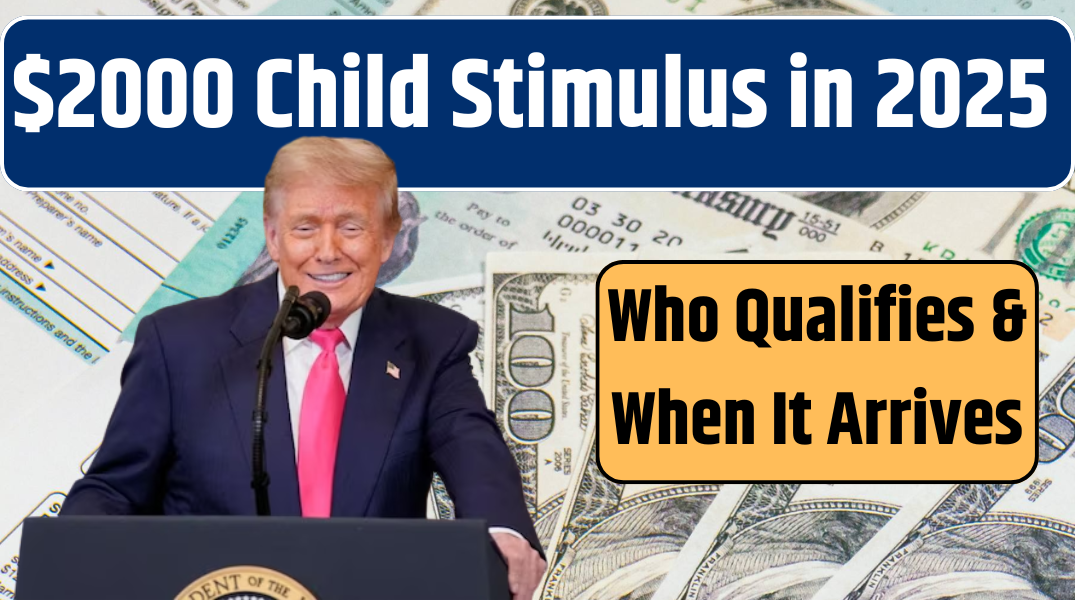As American families continue to face rising living costs, lawmakers are considering a proposed one-time $2000 child stimulus payment that could provide critical support to millions of households. This initiative, still awaiting final approval, has generated significant attention across the country.
If passed, the new stimulus would follow in the footsteps of past programs like the Child Tax Credit expansion of 2021, but with a few key differences. Here’s a breakdown of what we know so far—and how families can prepare.
Understanding the $2000 Child Payment Proposal
The proposed child stimulus is part of a broader effort to ease the financial burden on families raising children. Unlike recurring monthly payments offered in 2021, this plan would provide a one-time lump sum of $2000 per eligible child.
The funds are designed to help cover rising costs in childcare, groceries, rent, and back-to-school expenses—especially as economic challenges persist into 2025. While not yet finalized, the proposal has gained traction in both federal and state-level discussions.
Who Might Qualify for the Payment?
While specific details are still being debated, eligibility is expected to follow guidelines similar to past stimulus and Child Tax Credit programs.
Projected Eligibility Requirements:
-
Child Age: Must be under 17 years old at the end of 2024.
-
Filing Status and Income Limits:
-
Single filers: Income under $75,000
-
Head of household: Income under $112,500
-
Married couples (joint): Income under $150,000
-
-
Children must live with the filer for more than half the year and have a valid Social Security number.
Families with incomes slightly above the thresholds may still receive partial payments, depending on the final structure of the program.
How Will Payments Be Issued?
If approved, most families will not need to apply separately. Payments would likely be processed by the IRS and delivered through:
-
Direct deposit (if you’ve used it for tax refunds)
-
Paper check or debit card, if no direct deposit is on file
Those who haven’t filed taxes recently, such as low-income or non-filing families, may need to use an IRS online portal or submit a simple tax return to receive the payment.
✅ Tip: Update your tax information now to ensure all dependents are listed correctly—especially if you had a new child in 2024.
When Could Payments Arrive?
Should the bill pass through Congress by mid-year, payments are expected to roll out in Fall 2025, just ahead of the holiday season—a time when extra cash can go a long way in helping families stay afloat.
Quick Reference: Proposed $2000 Child Stimulus Summary
| Category | Details |
|---|---|
| Payment Amount | $2000 per qualifying child |
| Child Eligibility | Under 17 years old |
| Income Caps | $75K (single), $112.5K (head of household), $150K (married) |
| How to Claim | Automatic for most taxpayers; special portal for non-filers |
| Projected Start Date | Fall 2025 (pending legislation approval) |
| Usage Suggestions | Groceries, rent, school supplies, childcare |
Interesting Insight: Did You Know?
In 2021, the expanded Child Tax Credit reduced child poverty in the U.S. by more than 40%—but only temporarily. Analysts say even a one-time boost like this proposed $2000 could reduce financial strain for tens of millions of households, especially in under-resourced communities.
FAQs: $2000 Child Stimulus
Q1: Is the $2000 child payment confirmed?
Not yet. The proposal is under discussion at both federal and some state levels. There is no final legislation as of now.
Q2: What if I had a baby in 2024?
If the stimulus is approved, make sure your 2024 tax return includes your newborn’s information. This ensures you’re counted for the full benefit.
Q3: Will this payment affect my other benefits?
No impact is expected on SNAP, Medicaid, or housing benefits. These payments are generally considered tax credits, not income.
Q4: How can I make sure I don’t miss out?
-
File your 2024 tax return on time
-
Keep address and banking information updated with the IRS
-
Monitor irs.gov and usa.gov for official updates
Q5: Could states offer their own versions?
Yes. Some states like California and Colorado have issued child tax rebates or stimulus checks independently in the past. Similar programs may emerge depending on local legislation.
Final Thoughts
While not yet finalized, the proposed $2000 child stimulus is a beacon of hope for families navigating a still-uncertain economy. With the possibility of Fall 2025 payments, now is the time to prepare—by filing taxes, verifying dependents, and staying informed through trusted sources.
In a time when every dollar counts, this initiative could provide a much-needed lifeline for America’s working families.












